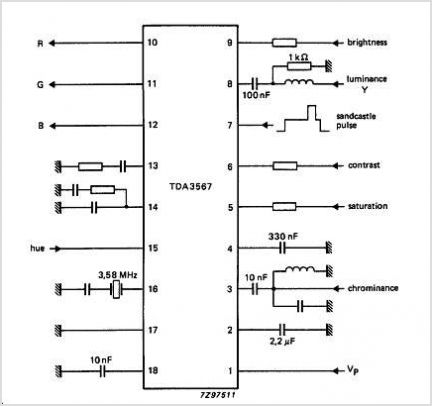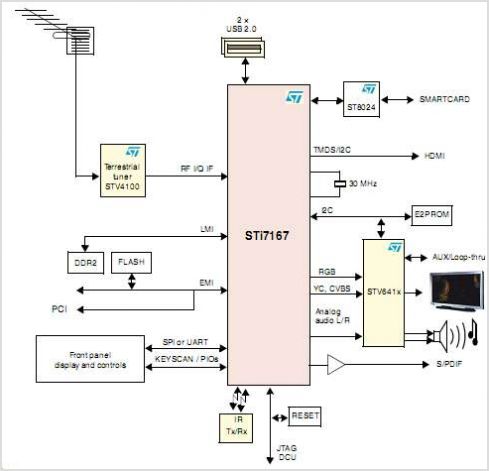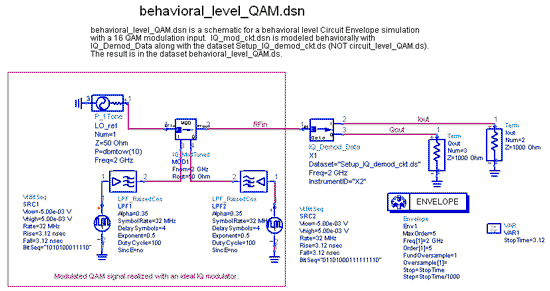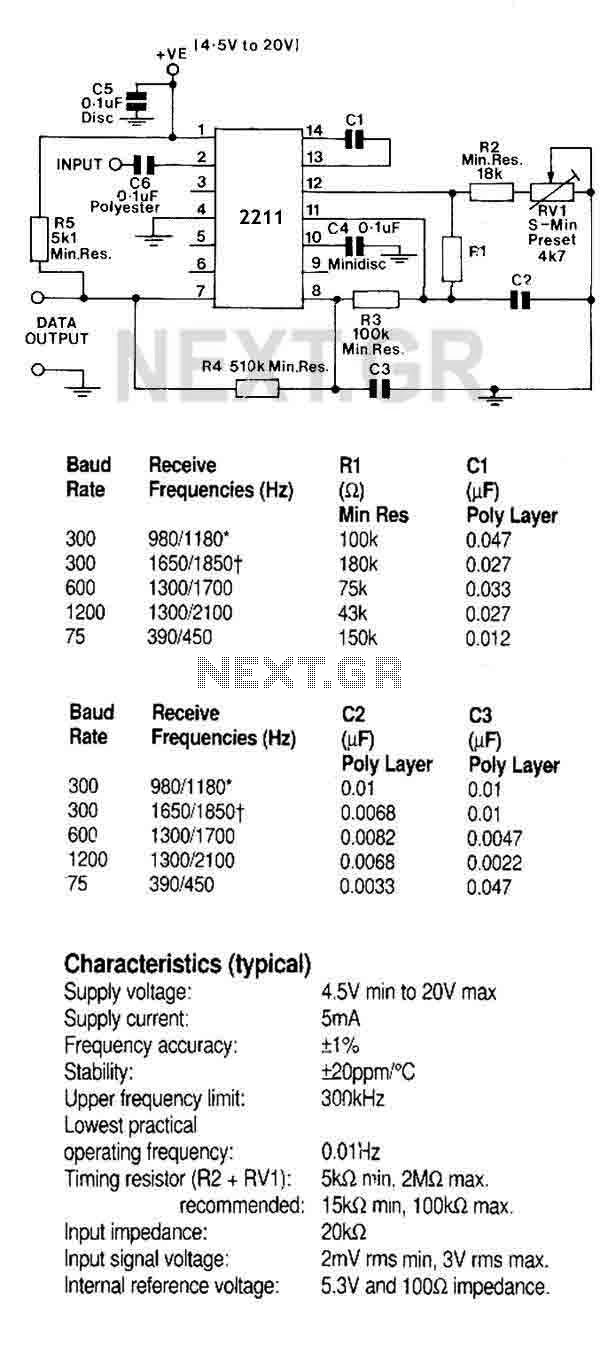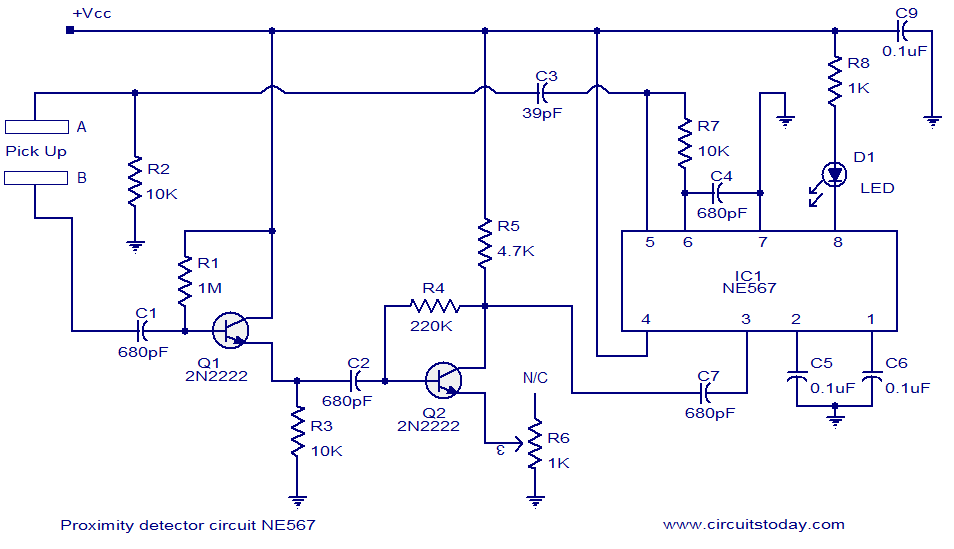
567 FM demodulator
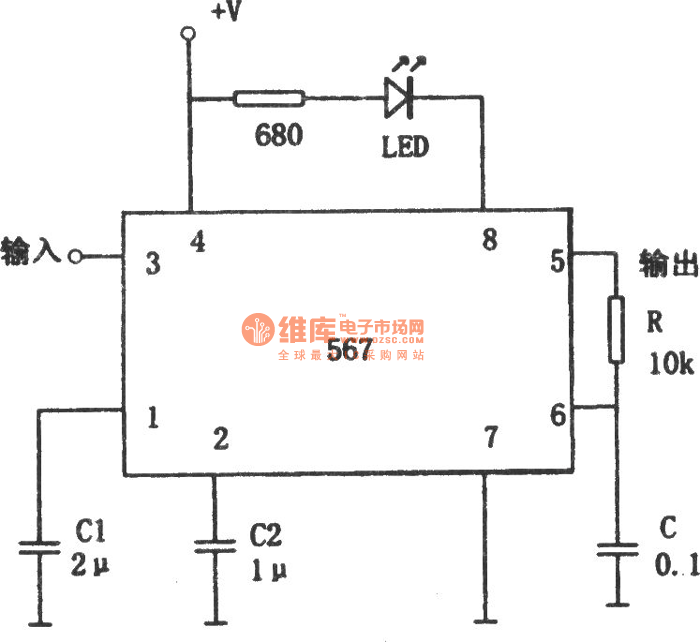
The circuit depicted in the figure is a 567 FM demodulation circuit. The FM signal enters through pin 3, and the demodulated output signal is available at pin 5. The center frequency of the FM signal that the circuit can demodulate is given by the formula: fo = 1.1 / (R * C), where C1 is the filter capacitor and C2 is the bandwidth adjustment capacitor. A decrease in the value of C2 results in an increase in the demodulation bandwidth.
The 567 FM demodulation circuit is designed to extract the original audio or data signal from an FM-modulated carrier wave. The circuit operates by utilizing phase-locked loop (PLL) technology, which allows for precise demodulation of frequency-modulated signals. The input FM signal is fed into pin 3, where it is processed by the internal components of the 567 IC.
The center frequency, denoted as fo, is crucial for the demodulation process and is determined by the resistance (R) and capacitance (C) values in the circuit. The relationship fo = 1.1 / (R * C) illustrates that the center frequency is inversely proportional to the product of R and C. Here, C1 serves as the filter capacitor, which helps in smoothing out the demodulated signal, while C2 acts as the bandwidth adjustment capacitor. Adjusting C2 allows for fine-tuning of the bandwidth of the demodulated signal; specifically, reducing C2 increases the bandwidth, thereby accommodating a wider range of frequency variations in the incoming FM signal.
In practical applications, this circuit is utilized in various communication systems where FM signals are prevalent, such as in radio broadcasting and telemetry. The output at pin 5 provides a clean, demodulated signal that can be further processed or amplified, depending on the requirements of the specific application. The design of the circuit emphasizes stability and reliability, making it suitable for both consumer and industrial electronics. Proper selection of R, C1, and C2 values is essential for optimizing performance and ensuring that the circuit meets the necessary specifications for the intended use.As shown in Figure it is 567 FM demodulation circuit. In the figue, the FM signalenters from the 3 foot, the demodulated signal goes out from 5 foot. FM signal center frequency which the circuit can demodulateis: fo = 1.1 / RC, C1 isfilter capacitor, and C2 is bandwidth adjustment capacitor. WhenC2 decreases, the demodulator demodulating bandwidth increase.. 🔗 External reference
The 567 FM demodulation circuit is designed to extract the original audio or data signal from an FM-modulated carrier wave. The circuit operates by utilizing phase-locked loop (PLL) technology, which allows for precise demodulation of frequency-modulated signals. The input FM signal is fed into pin 3, where it is processed by the internal components of the 567 IC.
The center frequency, denoted as fo, is crucial for the demodulation process and is determined by the resistance (R) and capacitance (C) values in the circuit. The relationship fo = 1.1 / (R * C) illustrates that the center frequency is inversely proportional to the product of R and C. Here, C1 serves as the filter capacitor, which helps in smoothing out the demodulated signal, while C2 acts as the bandwidth adjustment capacitor. Adjusting C2 allows for fine-tuning of the bandwidth of the demodulated signal; specifically, reducing C2 increases the bandwidth, thereby accommodating a wider range of frequency variations in the incoming FM signal.
In practical applications, this circuit is utilized in various communication systems where FM signals are prevalent, such as in radio broadcasting and telemetry. The output at pin 5 provides a clean, demodulated signal that can be further processed or amplified, depending on the requirements of the specific application. The design of the circuit emphasizes stability and reliability, making it suitable for both consumer and industrial electronics. Proper selection of R, C1, and C2 values is essential for optimizing performance and ensuring that the circuit meets the necessary specifications for the intended use.As shown in Figure it is 567 FM demodulation circuit. In the figue, the FM signalenters from the 3 foot, the demodulated signal goes out from 5 foot. FM signal center frequency which the circuit can demodulateis: fo = 1.1 / RC, C1 isfilter capacitor, and C2 is bandwidth adjustment capacitor. WhenC2 decreases, the demodulator demodulating bandwidth increase.. 🔗 External reference
